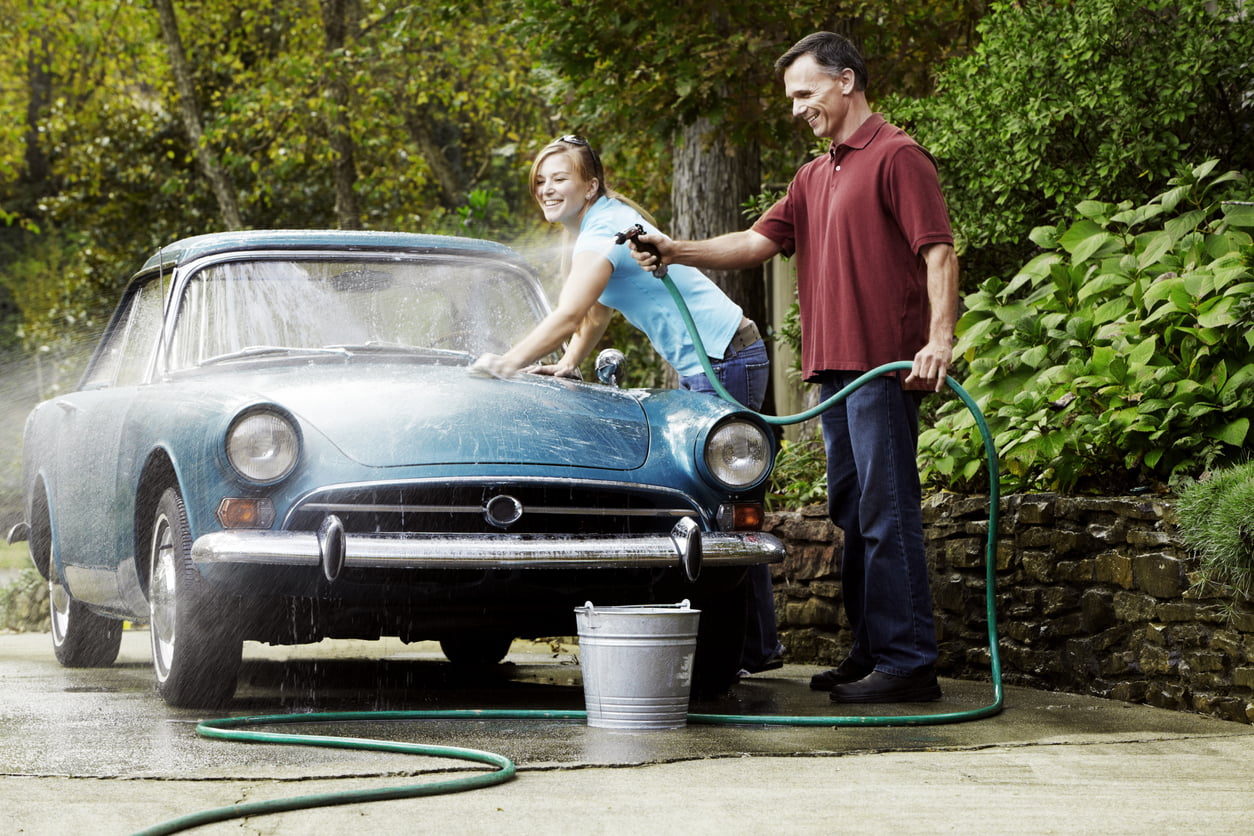
Taking care of a classic car isn’t the same as looking after a new one. Due to the age and condition of different components, old cars need lots of love and care to preserve their vintage appeal and avoid the corrosion of their original parts. But, as every classic car owner knows, maintaining them is all part of the joy of owning one.
If you’re new to classic car ownership, getting to grips with the upkeep and maintenance required to protect your car is one of the biggest challenges you face. So, to help out, we’ve put together a guide on how to look after a classic car, with a focus on maintaining your classic through the winter and getting it ready for spring.
As well as regular maintenance, many owners ‘hibernate’ their classics to protect them from the elements during the winter months. This is recommended for most old cars, as wet wintry roads are a big no-no. But there’s more to storing a classic car than simply parking it in a garage, which is why a section of this guide will also focus on long-term storage and upkeep.
In this, our ultimate guide to classic car storage and maintenance, we offer practical advice on storing your car to limit corrosion, as well as maintenance tips that will prevent long-term storage impacting on its performance. Use the links below to find the information you need.
Quick Links
- Maintaining a Classic Car
- Expert Advice for Maintaining a Classic Car
- Preparing Your Car for a New Season of Driving
- Storing a Classic Car
- Where to Store a Classic Car
- What to do Before Storing a Classic Car
- How to Maintain a Classic Car in Storage
Maintaining a Classic Car
Expert Advice for Maintaining a Classic Car
To help you take the best possible care of your vintage classic, we’ve even enlisted the help of an expert, Claus Stig Christensen, CEO of classic car rental portal, BookAclassic, so you can learn how the pros take care of their classics.
 Classic car expert Claus privately owns several classics, including a 1950s Jaguar MKII (pictured), which requires regular maintenance to retain its original style, condition and performance.
Classic car expert Claus privately owns several classics, including a 1950s Jaguar MKII (pictured), which requires regular maintenance to retain its original style, condition and performance.
“My Jaguar MKII is kept in a heated garage and I fire it up once a month or so to make sure the engine is running, then I do drive it a bit back and forth to make sure the tyres don’t deform from sitting in one spot for too long. If there’s a fantastic winter day when the sun is out, I do take it for a spin, but the salt they put on the road for the snow here in Denmark is something we do not want on our classic cars.
“If I know there’s salt on the roads during my drive, I take the garden hose and wash in the wheel arches, the lower parts of the car and also underneath, as far in as I can do. I’m careful only to take the Jaguar out when most of the salt on the streets has been washed away by rain.
“During winter, I try to get all the maintenance done that needs to be done because it’s a car that’s more than 50 years old and takes a lot of care. Once the season starts, I then know that it’s up and running and in good condition.”
Preparing Your Car for a New Season of Driving
As the warmer weather approaches, it’s time to prepare your car for a new season of driving. We’d recommend getting any maintenance tasks out the way before temperatures start to rise, so you can get out and enjoy the best of the dry weather.
 Here are some of the things you should do to prepare your car for spring and summer driving, particularly after a long period of winter storage:
Here are some of the things you should do to prepare your car for spring and summer driving, particularly after a long period of winter storage:
- Wax it – Before you head out, make sure the car is cleaned, polished and waxed, so the paintwork is fully protected from the elements. For a classic car, we’d recommend reapplying wax every few months to guarantee complete protection from grime, dirt and weather. (Obviously we recommend Simoniz Original Wax, which is a hard wax so lasts for up to six months).
- Service it – From tyre pressures to brake pads, you should give the car a thorough service before spring arrives, so you can rest assured that everything is good to go in time for your first drive out.
- Keep it clean – After every drive, we’d recommend hosing down the undercarriage of the car, where salt and road dirt can cause corrosion of untreated metal surfaces.
- Recharge the battery – Old car batteries may lose power in cold weather or when they haven’t been used regularly. Using a 12V battery charger, charge the battery manually before spring so you can avoid any non-starting problems.
Storing a Classic Car
After a joyous summer of driving, classic car owners need to start thinking about storing their classic car for the autumn and winter. This is an essential part of the maintenance which will help to prevent corrosion. Any damage could affect how it looks and performs, and also impact its value.
Here, we give you a step-by-step guide to winter classic car storage, as well as tips on maintaining a stored car so that it’s ready to go when the weather improves.
 Where to Store a Classic Car
Where to Store a Classic Car
Where you store your classic car is important. The space needs to offer protection from the weather, temperature extremes, moisture and, of course, it needs to be secure.
Here, we look at some of the common places where classic cars are kept and provide tips on protecting your car from the elements.
Brick Garage
A brick garage offers the very best protection for a classic car, whether it’s attached to a house or a standalone unit. Bricks do a great job of maintaining a stable temperature and moisture-free environment, which is what you need for preventing condensation in cold conditions.
Good to know:
- If there’s a big gap under your garage door, consider covering your car to protect it in cold weather. This will help prevent condensation.
- Keep an eye on the temperature of your garage. If it gets cold in winter and hot in summer, you’ll need to take action to protect your car.
- Upgrade the locks on your garage door. Standard garage door locks can be easy to break, so consider adding padlocks to make it more secure.
- Open the car windows slightly so that air can circulate through it.
 Pre-Cast Concrete or Wooden Unit
Pre-Cast Concrete or Wooden Unit
Other options for keeping a car inside include locking it in a pre-cast concrete or wooden compound, which you may have built specifically for housing your car. These are a quicker option if you don’t have the space, time or budget to build a brick garage, and will protect your car from the worst of the elements.
Alternatively, you could use a barn or outbuilding on your property, but we would recommend keeping the car covered in case animals or damp get into it. You can now get pop-up structures like a gazebo which are easy to put up and keep your car relatively sheltered, so you could also consider one of these if you have the space.
Good to know:
- Concrete compounds can lack breathability, with a reduced flow of air making it easier for mould and mildew to develop. To combat this, we’d recommend running a couple of fans in the space every week or so to circulate air and prevent things from going stale.
Outdoors
If your only option is to store your car outside, there are things you can do to protect it.
Invest in a cover which is purpose-built for your type of car; this will offer maximum protection and a close fit to prevent wind ‘rub’. If you can’t find a cover that’s built to the exact specification, go with one that’s slightly too big and then peg it in place so that everything’s covered. You need to protect it from direct sunlight as well as bird droppings, tree sap and moisture.
It’s also a good idea to lift your car off the ground if you can, as this will help protect the tyres, wheels and undercarriage from rain and moisture.
Good to know:
- Don’t use a standard tarpaulin to cover your classic car, only use a purpose-built car cover. Tarps and other plastic sheeting don’t offer the right kind of protection, and won’t let the car breathe, resulting in condensation, mould and mildew.
 What to do Before Storing a Classic Car
What to do Before Storing a Classic Car
Before your car goes into hibernation, there are few things to do to prepare it.
Check that the Space is Right for Your Car
Wherever you plan to store it, make sure the space is clean, dry and damp-free before parking your car, as any moisture could cause corrosion or mould.
Give the Car a Thorough Clean, Polish and Wax
If you want to protect it from corrosion, you’ll need to make sure your car is completely free from dirt, salt and moisture. That means giving it a thorough clean and waxing the paintwork to protect it.
Classic car owners will be no strangers to taking care of their car’s paintwork, so we won’t go into the nitty-gritty of washing, waxing and polishing here. We will say, though, that it’s absolutely vital that your car is completely dry before it goes into storage, as any moisture could cause rust when it’s left to stand for long periods.
You should also lubricate any rubber parts if you can, to stop them perishing.
 Open the Windows to Ensure Good Circulation
Open the Windows to Ensure Good Circulation
To prevent bad smells gathering in the car when it’s stood for weeks at a time, it’s always a good idea to open the windows to let fresh air circulate. Leaving the front windows slightly ajar will make all the difference to how fresh the cabin stays, so you won’t have to put up with any bad odours when it’s time to drive again. Fresh air is also important in helping to prevent mould.
Remember though, that mice and other small animals can get in through the windows so make sure there’s no crumbs or dirt in the car that will attract them.
Another top tip – if you’ve got a convertible then store it with the top up, as this will help it to keep its shape and stop the material from shrinking.
Disconnect the Battery
Car batteries will slowly eke-out power when they’re not in use, so it’s a good idea to disconnect it to preserve its charge. Failing that, you could start the car every few weeks and run it for 10 minutes to charge the battery, or use a smart charger which will monitor the battery’s power and give it a small charge when it needs it.
Keep the Car Out of Direct Sunlight
Is the space you’re storing your car in exposed to direct sunlight? If so, you’ll need to cover up the paintwork to prevent it from fading in the sun. Older car paints, such as those used on classics, are susceptible to damage from direct sunlight, so you must cover up your car even if the sun’s only on it for a couple of hours each day.
The easiest way to protect the car from the sun’s rays is with a cover. Just make sure you choose a breathable one that’s made for your car.
 How to Maintain a Classic Car in Storage
How to Maintain a Classic Car in Storage
Once your car is laid-up and ready for winter, that doesn’t mean your work is over. You’ll need to maintain it regularly to make sure it stays in a driveable condition, and ready for those dry winter days when you want to head out for a nice drive.
Here are some of the things you should do to maintain your car through the winter:
- Check the fluid levels regularly: Switching on the ignition when your classic car is low on fluid could cause catastrophic engine damage, so make sure you check the fluids regularly, including the oil, coolant/antifreeze, brake fluid and transmission fluid. You should also make sure that the coolant/antifreeze in the system is winter-ready, so that it won’t freeze when the car is stood for long periods.
- Treat rust spots with quality lubricant: A lot of classic cars have minor rust spots, but these can easily worsen if left unchecked. When your car is stored for the winter, apply lubricant regularly to slow down the spread of rust and help prevent further corrosion.
- Run the engine every couple of weeks: Starting the car every couple of weeks is a good idea, as it will recharge the battery and allow fluids to circulate through the engine. It also gives you peace of mind that your car is ready to go when you feel the urge to drive it.
- Clean it after every drive: If you do decide to take your car out for a spin in the winter, it’s important to clean it afterwards. Even on dry days, salt from roads can get on the undercarriage of your car, and this could cause all sorts of problems if left unchecked. Wash the sills and undercarriage with a hose, and try to dry off any moisture before putting it back in the garage.
The Simoniz car care range can help you take care of your car inside and out, no matter what its age. To browse our product range, visit the homepage today.
